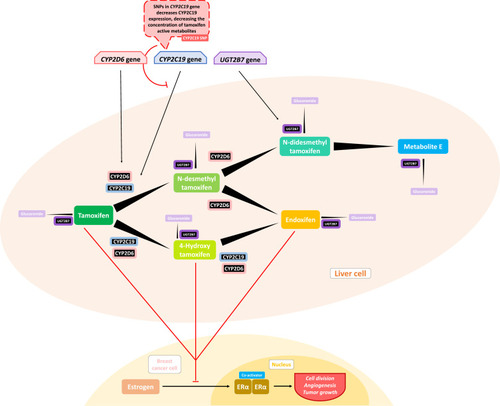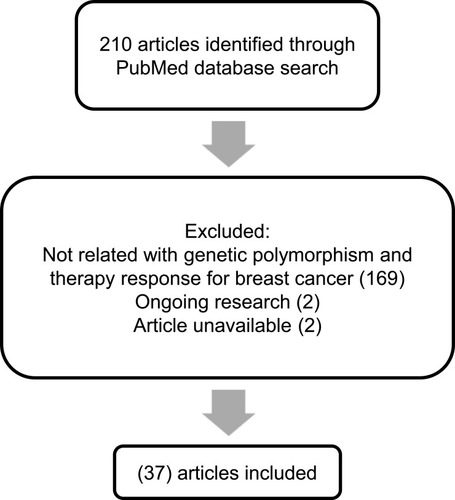Figures & data
Table 1 Association Between Genetic Polymorphism and Therapy Response
Figure 2 Influences of gene polymorphism with tamoxifen metabolism. Some of the chemoresistance mentioned in the paper are involving changes in drug metabolism and further decreased drug concentration in some individu. The decreased drug concentration may leads to suboptimal concentration needed to have therapeutic effect. CYP2C19 polymorphism may decrease CYP2C19 expression, which an enzyme that have a function in Phase I metabolism of tamoxifen needed to activate the substance into 4-hydroxy-tamoxifen and endoxifen, a more active metabolite in inhibiting estrogen-ER binding to halt tumor growth.

Figure 3 Possible mechanism of polymorphism influences related with MAPK and PI3K/AKT cell signaling. Drug resistance from some of the genes are resolved around MAPK and PI3K/AKT cell signaling. Polymorphisms in some genes mentioned may induce chemoresistance by disrupting the normal cell proliferation signaling and increase the aggressiveness of the tumor. The MAPK pathway are activated after Ras was phosphorylated and may induce cell proliferation, angiogenesis, and tumor growth. Ras may also activate PI3K, which further phosphorylating AKT that leads to activation of various signaling pathway leading to increase tumor growth rate. Genes that are hypothesized to disrupt these signaling are HER2, HER3, VEGFR2, and FGFR4. Polymorphism of HER2 and HER3 may increase receptor expression and this upregulation may further leads to increased MAPK/AKT signaling. In HER3 rs2229046 carrier, Src expression is increased and leads to increase MAPK/AKT signaling, and those with rs77123 had heightened concentration of GSK-3β, that may inhibit c-myc as tumor growth suppressor and is suggested as chemoresistance mechanism. In FGFR4 arg388 carrier, uPAR expression is increased and further inhibits TRAIL-induced apoptosis that leads to tumor cells resisting the induction of apoptosis.
 Indicates phosphorylation process.
Indicates phosphorylation process.  Activates/transactivates/upregulates/expresses.
Activates/transactivates/upregulates/expresses.  Inhibits/downregulates.
Inhibits/downregulates.




